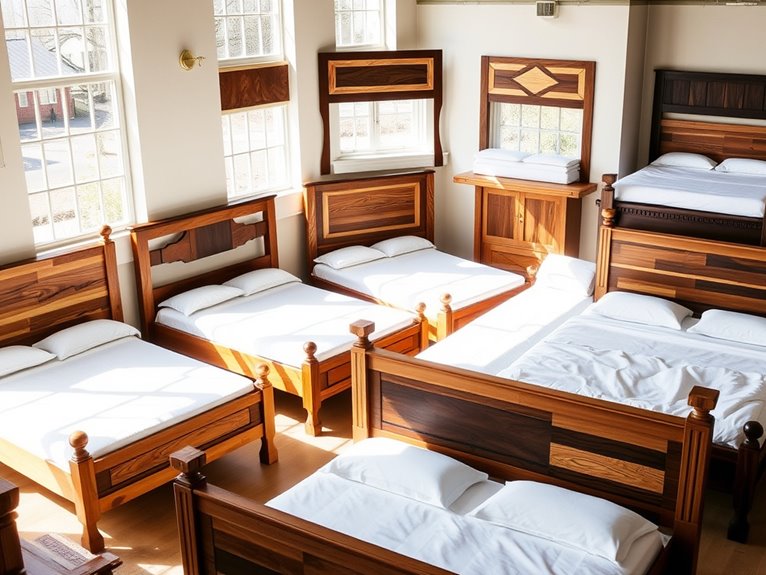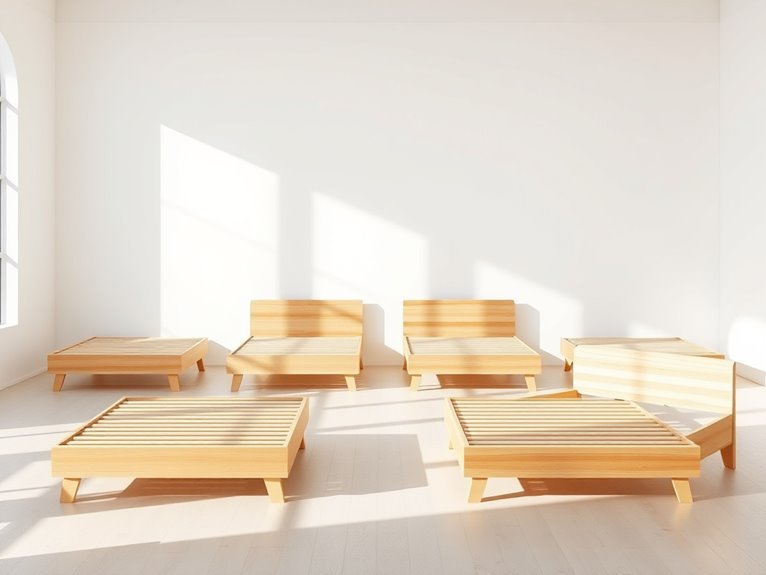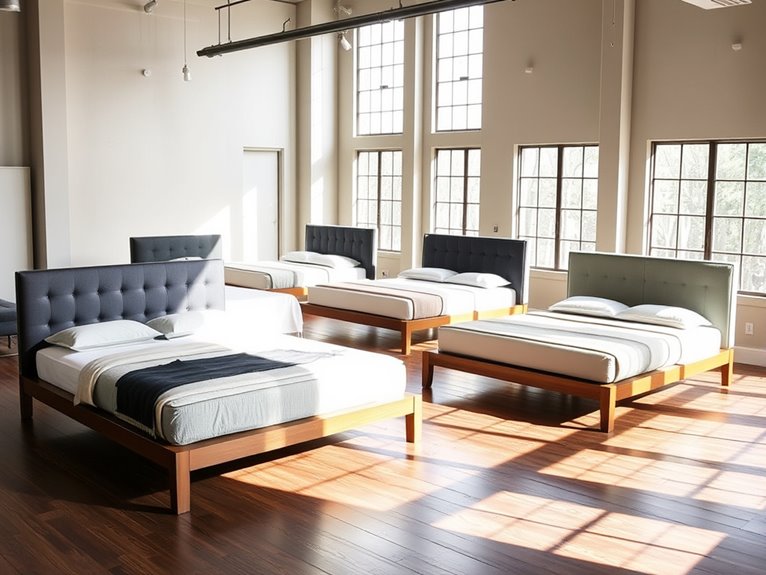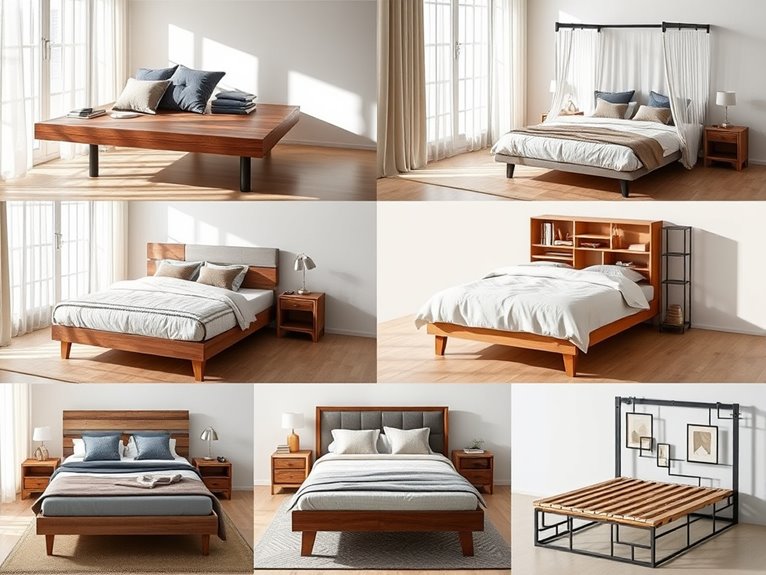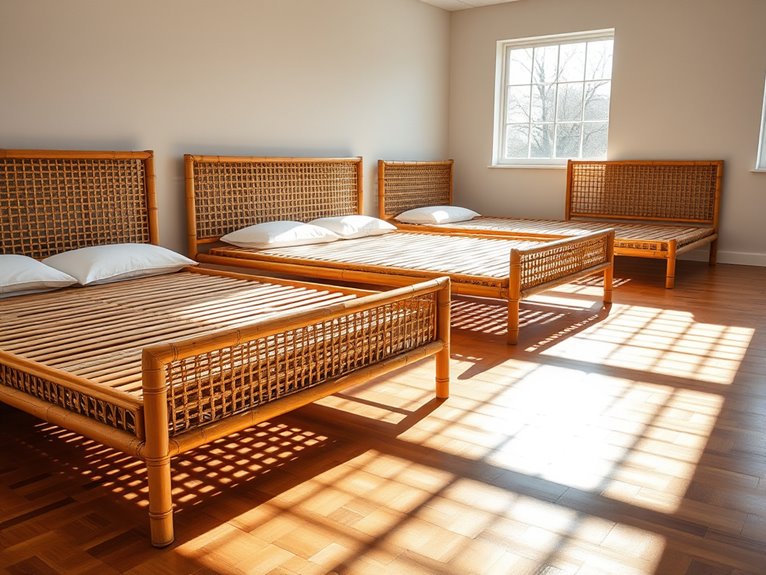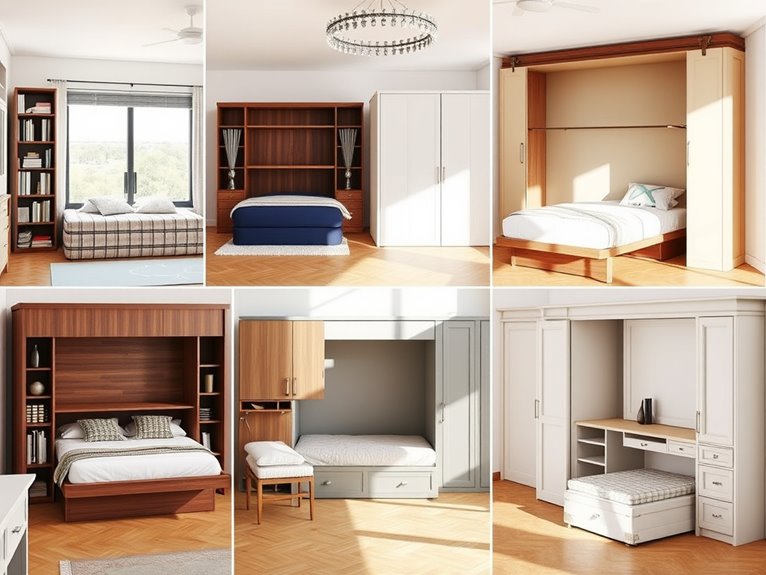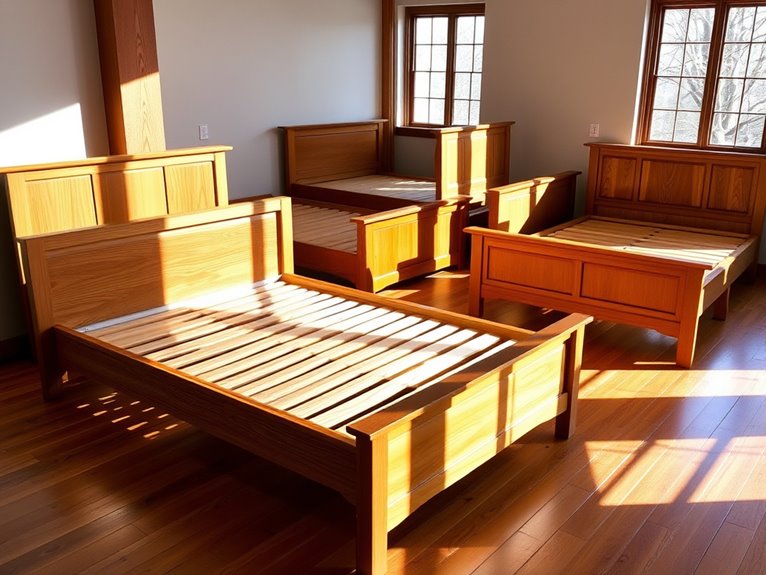9 Local Artisan Beds
You’ll discover a world of handcrafted luxury in these nine artisan beds, each telling its own story through carefully selected materials and time-honored techniques. From the weathered warmth of reclaimed barn wood to the sleek curves of hand-forged iron, local craftsmen have poured their expertise into creating pieces that transcend ordinary furniture. As you explore these distinctive designs, you’ll find that every joint, finish, and detail reflects a perfect balance of beauty and craftsmanship, transforming your bedroom into a sanctuary of authentic artistry.
The Reclaimed Barn Wood Platform Bed
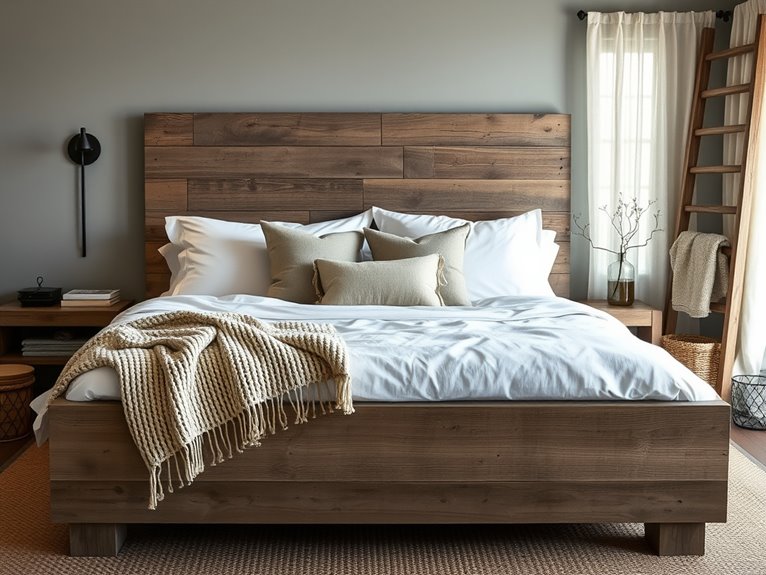
Rustic elegance meets sustainable design in the Reclaimed Barn Wood Platform Bed styling approach. The weathered patina of authentic barn wood creates a commanding focal point that brings warmth and character to any bedroom space.
The natural variations in color, from silvery grays to rich browns, combined with the wood’s distinctive grain patterns and occasional nail holes or markings, tell a story of history and craftsmanship that modern furniture simply can’t match.
This styling technique works particularly well in farmhouse, industrial, or modern rustic interior designs, especially during fall and winter months when organic textures feel most appropriate.
The substantial presence of reclaimed wood provides an ideal foundation for layering cozy textiles and creating an inviting sanctuary. While this style shines in larger bedrooms where the substantial frame can breathe, it can be equally impactful in smaller spaces when paired with minimalist décor.
Essential Components:
- Crisp white cotton sheets
- Chunky knit wool throw blanket
- Natural linen duvet cover
- Various sized pillows in neutral tones
- Woven jute area rug
- Metal or vintage-style bedside lamps
- Galvanized metal accessories
- Wire basket or wooden crate for storage
- Natural fiber throw pillows
- Cotton rope accents
How to Achieve This Look:
Start with a clean, well-positioned platform bed frame, ensuring the reclaimed wood is properly sealed to prevent splinters while maintaining its authentic appearance.
Layer the bed with high-quality white sheets as your base, followed by a natural linen duvet in earth tones like oatmeal, stone, or warm gray to complement the wood’s natural coloring.
Create depth through thoughtful pillow arrangement, starting with standard pillows in white cotton cases, followed by Euro shams in textured natural fabrics.
Add accent pillows in varying sizes, incorporating materials like wool, canvas, or raw cotton in muted, complementary colors. A chunky knit throw blanket casually draped across the foot of the bed adds essential texture while maintaining the organic feel.
The surrounding space should echo the bed’s rustic elements while maintaining balance.
Position industrial-style lighting fixtures on either side, and incorporate metal accents through picture frames or decorative objects.
Consider adding a vintage ladder as a blanket display or introducing woven baskets for storage to reinforce the artisanal aesthetic.
Pro Styling Tips:
For maximum impact, mix textures while maintaining a controlled color palette of no more than three main neutral shades.
During warmer months, swap heavy knits for lightweight cotton throws and introduce subtle patterns through pillow covers.
In smaller spaces, elevate the bed slightly higher to create the illusion of more floor space, and use mirrors to reflect light off the wood’s surface.
To maintain the bed’s appearance, regularly dust the wood frame with a soft cloth and rotate textiles weekly to prevent wear patterns from forming.
A designer secret is to slightly rumple the duvet cover and position throws at asymmetrical angles for that coveted “lived-in luxury” look that photographs beautifully.
Hand-Forged Iron Canopy Design
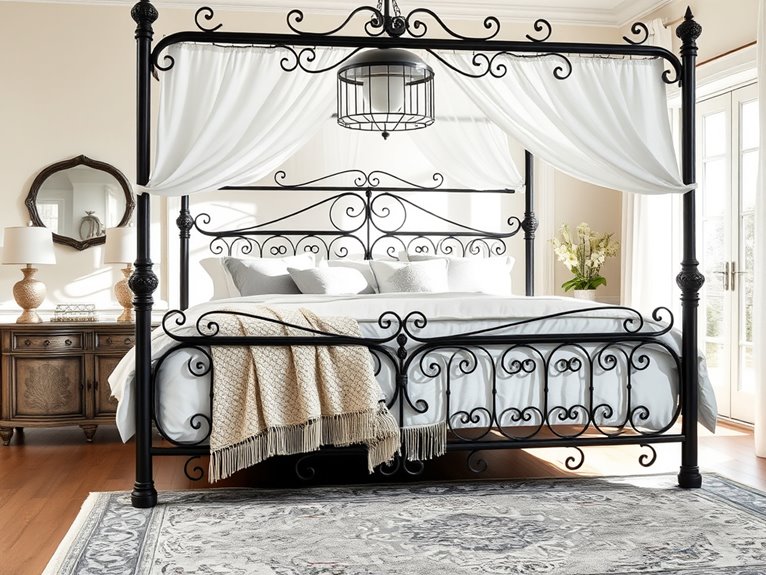
The dramatic silhouette of a hand-forged iron canopy bed creates an immediate focal point in any bedroom, combining Old World craftsmanship with timeless elegance. The intricate metalwork, featuring custom-hammered details and artistic scrollwork, casts enchanting shadows across walls and bedding while providing a framework for luxurious fabric draping or seasonal decorative elements.
This styling technique particularly excels in rooms with high ceilings and works year-round, though it takes on different personalities with seasonal styling changes. In summer, light, ethereal fabrics create an airy retreat, while winter calls for heavier textiles and richer textures. The versatility of iron canopy beds allows them to complement various design styles, from romantic European to industrial modern, making them an excellent investment piece for design-conscious homeowners.
Essential Components:
- High-quality cotton or linen sheets
- Duvet cover with matching shams
- Decorative pillows in varying sizes
- Canopy fabric panels
- Fabric ties or hooks
- Metal curtain rings
- Stepladder
- Iron bed frame maintenance kit
- Accent throws
- Bedskirt or dust ruffle
- Antique-finish metal polish
How to Achieve This Look
Begin by ensuring the iron frame is clean and polished, allowing the metalwork’s details to shine. Position the bed where the canopy height works harmoniously with the ceiling, ideally centered on a wall to maximize its architectural impact. Install curtain rings or fabric ties at strategic points along the upper frame to support your chosen canopy treatment.
Layer the bedding starting with crisp sheets in neutral tones that complement the iron’s finish. Add a substantial duvet or coverlet that drapes well over the sides, creating clean lines that don’t compete with the frame’s intricacy. Choose fabrics that provide textural contrast to the metal – soft linens and plush velvets work particularly well against the hard surfaces of the frame.
For the canopy treatment, select fabrics that enhance rather than overwhelm the metalwork. Sheer panels in white or ivory create an ethereal effect, while deeper colors like charcoal or navy add drama. Consider seasonal switches – lightweight cotton for spring/summer and heavier damask or velvet for fall/winter.
Color combinations that particularly complement iron frames include gray and cream, navy and white, or sage and ivory.
Pro Styling Tips:
To maintain the bed’s sophisticated appearance while making it practical for daily use, invest in high-quality fabric panels that can be easily removed and laundered. Use magnetic curtain ties to secure canopy fabrics without damaging the iron frame, and keep extra panels on hand for quick seasonal changes.
For smaller rooms, opt for shorter side panels rather than full-length draping to maintain the aesthetic without overwhelming the space. Regular dusting of the frame with a specialized metal cleaner will preserve the finish and prevent any rust development that could transfer to fabrics.
Live Edge Walnut Masterpiece
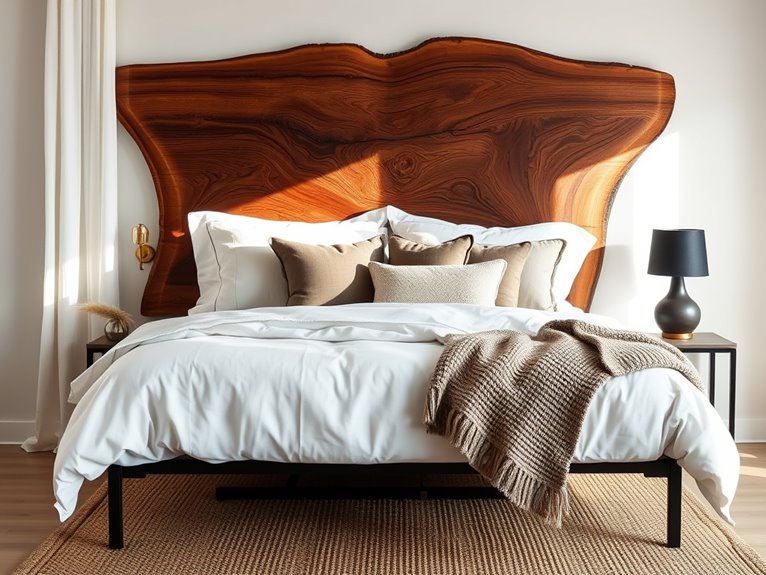
A live edge walnut headboard serves as a stunning focal point that brings organic warmth and natural sophistication to any bedroom space. The raw, untamed edge of the walnut slab creates a striking contrast against crisp linens, while the rich chocolate tones of the wood grain add depth and character that can’t be replicated with manufactured furniture.
This dramatic centerpiece exemplifies the perfect marriage between rustic charm and modern luxury. This styling technique works particularly well in contemporary and modern rustic bedrooms, especially during fall and winter when warm, organic elements feel most appropriate.
The versatility of walnut’s natural coloring allows it to pair beautifully with both neutral and bold color schemes, making it an investment piece that adapts to changing design preferences. The style is ideal for master bedrooms or luxury guest suites where a statement piece can truly shine.
Essential Components:
- Live edge walnut headboard
- White or cream organic cotton sheets
- Textured linen duvet cover
- Natural wool throw blanket
- Earth-toned decorative pillows
- Brass or black metal bed frame
- Woven jute area rug
- Ceramic bedside vessels
- Minimalist metal sconces
- Natural fiber window treatments
How to Achieve This Look
Begin by positioning the live edge walnut headboard as the room’s centerpiece, ensuring it’s properly mounted and secured. The natural height of the headboard should extend approximately 24-30 inches above the mattress top for optimal visual impact.
Install complementary lighting fixtures that cast a warm glow on the wood’s surface, highlighting its natural grain patterns. Layer the bedding starting with crisp white sheets as your foundation.
Add a substantial linen duvet in a warm neutral tone like oatmeal or greige, allowing natural wrinkles to create organic texture. Position euro shams in a deeper earth tone against the headboard, followed by standard pillows in coordinating cases.
Complete the arrangement with 2-3 decorative pillows in varying textures and neutral hues. The color palette should draw from the walnut’s natural variations.
Work with rich browns, soft taupes, and warm grays, incorporating subtle variations in texture rather than bold patterns. When photographing this style, capture the bed from multiple angles to showcase the headboard’s unique edge and natural wood grain.
Morning light typically provides the best illumination for highlighting the wood’s rich coloring.
Pro Styling Tips
Maintain visual balance by keeping side tables proportional to the headboard’s scale and echo the wood’s organic feel with natural accessories. For summer months, swap heavy textiles for lighter linens in similar earth tones, and add throws in cooling sage or clay colors.
In smaller rooms, choose a headboard with a more subtle live edge to prevent overwhelming the space. To preserve the wood’s beauty, dust regularly with a soft cloth and treat the surface annually with natural wood oil to maintain its rich luster.
Modern Industrial Steel Frame
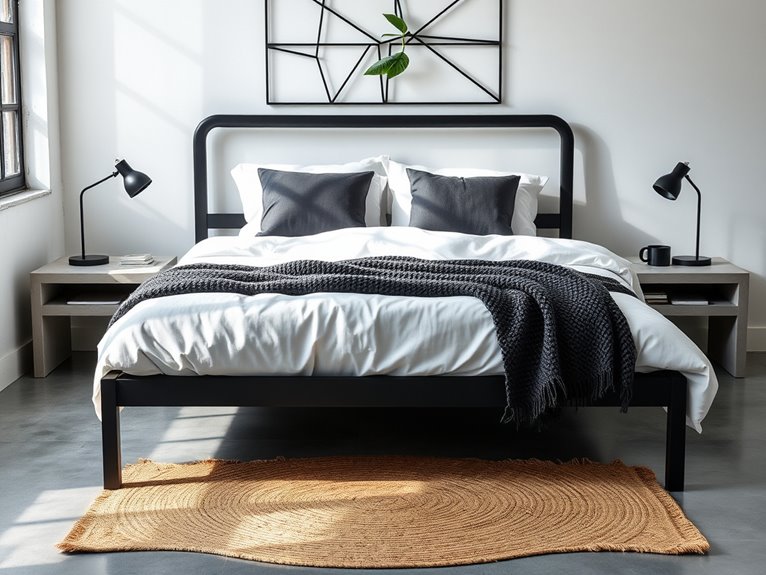
The striking combination of raw steel and soft textiles creates an arresting visual contrast that defines the modern industrial steel frame aesthetic. The clean lines and minimal structure of the frame serve as a bold architectural element, while also providing an ideal canvas for layering luxurious bedding. This style makes a powerful statement through its deliberate juxtaposition of industrial materials with comfortable, inviting textiles.
This styling technique works particularly well in urban lofts, converted warehouses, or any space seeking to embrace contemporary design with an edge. While suitable year-round, the look especially shines during fall and winter months when deeper colors and heavier textures can be incorporated to soften the metal framework. The style adapts beautifully to both spacious rooms where the frame can command attention and smaller spaces where its streamlined design prevents visual clutter.
Essential Components:
- Steel bed frame with clean lines
- White or gray fitted sheet
- Crisp white flat sheet
- Down or down-alternative duvet insert
- Linen or cotton duvet cover in neutral tones
- 4-6 pillows in varying sizes
- Industrial-style bedside lamps
- Concrete or metal side tables
- Natural fiber area rug
- Metal wall art or industrial-style mirror
- Black or gray throw blanket
- Leather or canvas accent pillows
How to Achieve This Look
Begin by positioning the steel frame as the focal point of the room, ensuring equal space on both sides for accessibility and balance. Select bedding in a monochromatic palette, starting with high-quality white sheets as your base layer. The fitted sheet should be pulled taut to emphasize the clean lines of the frame.
Layer the bed with a neutral-toned duvet cover, preferably in slate gray, charcoal, or warm taupe to complement the steel frame. Create depth by adding textural elements through pillow arrangements, starting with standard pillows in crisp white cases, followed by larger Euro shams in contrasting materials like leather or canvas. Position a carefully rumpled throw blanket across the foot of the bed for an effortless yet intentional look.
Complete the styling by incorporating industrial-inspired accessories that echo the frame’s aesthetic. Select bedside lighting with exposed bulbs or metal shades, and add geometric or mechanical-inspired wall art. When photographing the style, capture angles that highlight the frame’s architectural qualities while showing the interplay between hard and soft elements. Natural light works best to showcase the metal’s subtle variations and the bedding’s texture.
Pro Styling Tips
To elevate this look, incorporate unexpected organic elements like raw wood or living plants to prevent the space from feeling too stark or cold. For summer, swap heavy textiles for lighter linens and add bright white accents; in winter, introduce deeper tones and chunky knit throws.
In smaller rooms, choose a frame with a smaller footprint and limit decorative elements to maintain the industrial aesthetic without overwhelming the space. To keep the look pristine, invest in quality bedding that won’t wrinkle easily and regularly dust the frame to maintain its metallic luster.
A designer secret is to slightly angle corner pillows to create subtle asymmetry, making the bed appear more inviting while maintaining its modern edge.
Traditional Pine Four-Poster
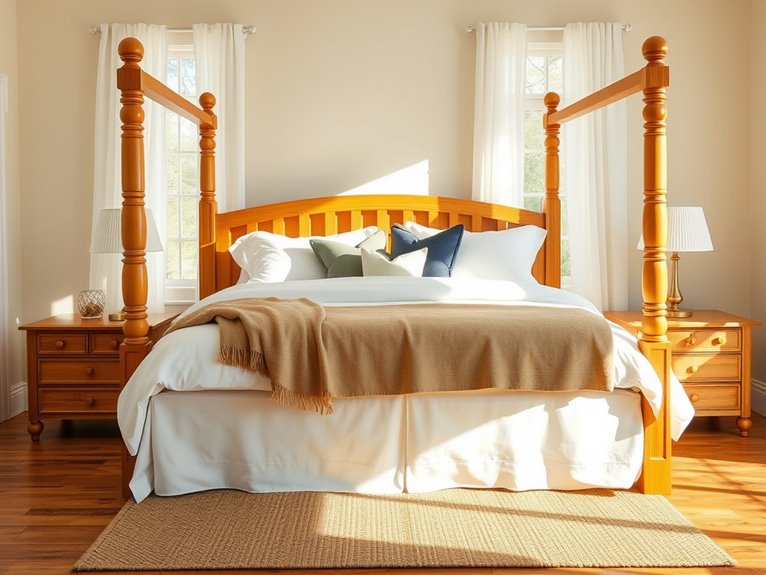
The timeless appeal of a traditional pine four-poster bed lies in its rustic elegance and commanding presence in any bedroom. The natural warmth of pine wood, combined with classic architectural details and traditional bedding elements, creates a cozy yet sophisticated focal point that bridges the gap between country charm and refined style. The vertical lines of the posts draw the eye upward, making any room feel more spacious and grand.
This styling technique particularly shines in country homes, farmhouse-style bedrooms, or traditional spaces where natural materials and heritage design elements are celebrated. The look works exceptionally well during fall and winter months when layered textiles and warm tones create an inviting sanctuary, though it can be lightened for spring and summer with appropriate fabric choices. The versatility of pine allows it to complement both neutral and bold color schemes.
Essential Components:
- High-quality white cotton sheets
- Quilted bedspread or coverlet
- European pillows (2-3)
- Standard pillows (2-4)
- Decorative throw pillows
- Bed skirt or dust ruffle
- Cotton or linen duvet
- Wool or cotton throw blanket
- Fabric ties for posts (optional)
- Sheer curtain panels (if creating canopy)
- Brass or iron curtain hardware
- Natural fiber area rug
- Bedside lamps with linen shades
How to Achieve This Look
Begin with a proper foundation by dressing the bed with crisp, white fitted and flat sheets, ensuring hospital corners for a polished look. Layer a quilted mattress pad underneath for added comfort and to create a smooth surface for additional bedding layers. The bed skirt should be pressed and hung to just touch the floor, creating clean lines around the bed’s base.
Build the layers starting with a substantial coverlet or bedspread in a neutral tone that complements the pine’s natural color. Traditional patterns like toile, damask, or subtle stripes work beautifully. Position European pillows against the headboard, followed by standard pillows in crisp white shams, then add decorative pillows in descending size order. The key is to create a pyramidal arrangement that appears both inviting and orderly.
Color combinations that enhance pine’s natural warmth include ivory and sage, wheat and navy, or cream and burgundy. When styling for photographs, position the bed at a 45-degree angle to capture both the height of the posts and the layered bedding details. Natural lighting from windows will highlight the wood’s grain and create depth in the bedding textures.
Pro Styling Tips
For a designer-worthy finish, iron or steam all bedding before styling, and keep a small steamer handy for quick touch-ups. Scale the number of pillows to your room size – fewer for smaller spaces, more for master suites.
During summer months, replace heavy fabrics with lightweight linens and remove excess layers while maintaining the structured look. To keep the style fresh with daily use, train yourself to spend an extra minute each morning smoothing the coverlet and fluffing pillows – this small effort maintains the bed’s polished appearance throughout the day.
Minimalist Oak Floating Base
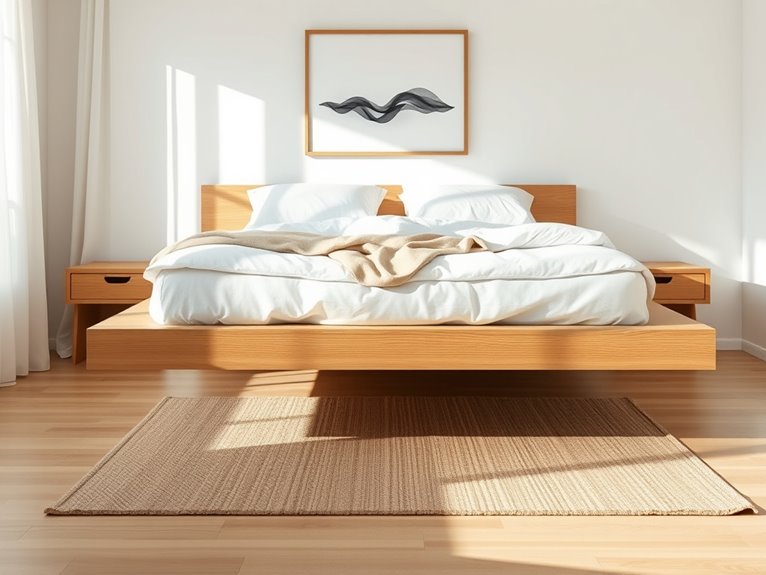
The Minimalist Oak Floating Base style embodies modern simplicity while maintaining a warm, organic presence in the bedroom. The clean lines of the oak platform create an illusion of floating, drawing the eye horizontally across the space while eliminating visual clutter beneath the bed. This architectural approach to bed design transforms the sleeping area into a contemporary sanctuary that feels both grounded and weightless simultaneously.
This styling technique works particularly well in modern and Scandinavian-inspired interiors, where natural materials and minimalist design principles reign supreme. The floating base design is especially effective in smaller spaces, as it creates an airy feeling and allows light to flow underneath the bed frame. While this style shines year-round, it’s particularly striking during spring and summer months when paired with light, natural textiles that complement the oak’s warm tones.
Essential Components:
- Oak platform bed frame with floating design
- White linen duvet cover
- Natural cotton sheets
- Low-profile mattress
- Linen or cotton pillowcases (2-4)
- Neutral throw blanket
- Small accent pillows (2)
- LED strip lighting (optional)
- Natural fiber area rug
- Simple bedside tables
- Minimal artwork
How to Achieve This Look
Begin by positioning the oak floating base away from walls to emphasize its suspended design. The key is to maintain adequate space on all sides, allowing the floating effect to be visible from multiple angles.
Install the mattress, ensuring it sits perfectly centered on the platform without overhanging edges. Layer the bed with crisp, high-quality linens in neutral tones that complement the oak’s natural color. Start with fitted sheets in pure white or light beige, followed by a matching flat sheet.
The duvet cover should be slightly textured but minimal in pattern, focusing on natural materials like linen or cotton in shades of white, cream, or light gray. For the finishing touches, arrange pillows in a simple, symmetrical formation, avoiding excessive decorative elements.
The goal is to maintain clean lines while adding subtle depth through texture variations. Colors that work particularly well include warm whites, sand tones, and soft grays, with occasional earth-toned accents that echo the oak’s natural beauty.
Pro Styling Tips:
For maximum impact, maintain a three-inch gap between the floating base and any area rug placed underneath – this emphasizes the floating effect while adding depth to the room.
During warmer months, style with lighter linens and remove heavy throws; in winter, add warmth through textured throws and additional pillows while maintaining the minimal aesthetic.
To preserve the clean look daily, invest in high-quality linens that naturally resist wrinkling, and consider using a simple wooden valet stand nearby to prevent clothing from accumulating on the bed’s clean lines.
Copper-Accented Maple Statement Piece
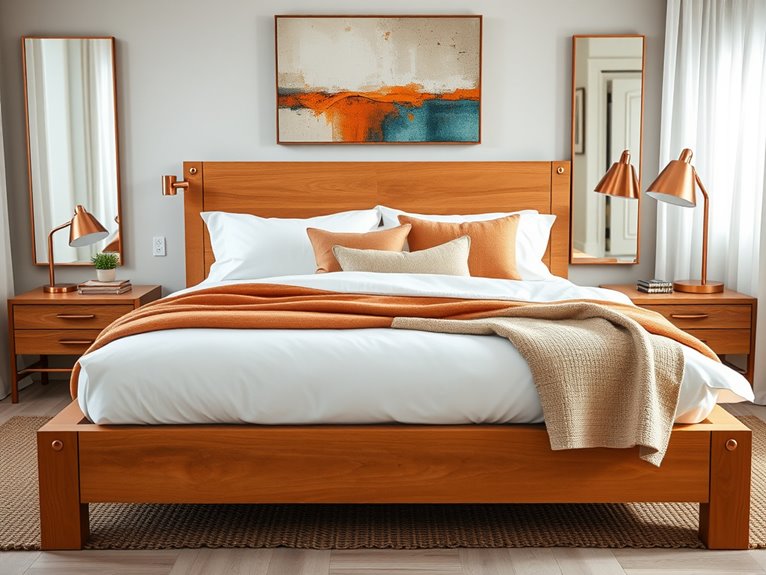
The marriage of warm maple wood and gleaming copper accents creates a sophisticated yet approachable bedroom centerpiece that draws inspiration from both modern and artisanal design sensibilities.
This statement bed combines the natural richness of maple’s honey tones with carefully placed copper elements, resulting in a luxurious sleeping space that feels both grounded and elegantly elevated.
This styling technique works particularly well during autumn and winter months when warm metallics and natural materials create a cozy sanctuary, though it can be adapted year-round through thoughtful textile choices.
The style is especially suited to contemporary craftsman, industrial modern, or transitional bedroom designs where the interplay of natural materials and metallic finishes can take center stage.
Essential Components:
- Maple bed frame with clean lines
- Copper-finished hardware or accent pieces
- White or cream base bedding set
- Terracotta or rust-colored duvet cover
- Textured neutral throw pillows
- Copper-threaded decorative pillows
- Woven throw blanket
- Copper bedside lamps or sconces
- Natural fiber area rug
- Copper picture frames or wall art
- Microfiber cleaning cloth for copper maintenance
How to Achieve This Look
Begin by positioning the maple bed frame as the foundation, ensuring the wood grain is visible and well-maintained.
Add crisp white sheets as your base layer, followed by a terracotta or rust-colored duvet that echoes the copper accents. The bedding should be pulled taut and corners precisely folded to create clean lines that complement the bed frame’s geometry.
Layer the pillows starting with standard sleeping pillows in white cases, followed by Euro shams in a complementary neutral tone.
Add decorative pillows featuring copper threads or metallic embellishments, arranging them in descending size order.
The final layer should include a textured throw blanket draped asymmetrically across the foot of the bed, introducing visual interest while maintaining sophistication.
The copper elements should be strategically placed to create a cohesive flow throughout the space.
Install copper-finished sconces or place copper table lamps on bedside tables.
Select artwork or mirrors with copper frames to extend the metallic theme vertically, creating balance with the horizontal planes of the bed.
Colors that work particularly well include deep teals, soft greys, and warm whites, which allow the copper and maple to remain the focal points.
Pro Styling Tips
For maximum impact, concentrate copper accents at varying heights throughout the room rather than clustering them in one area, and consider using copper-colored silk throw pillows instead of actual metallic fabrics for a more practical, maintenance-friendly approach.
Scale the amount of copper according to room size – larger spaces can handle more metallic elements, while smaller rooms benefit from fewer, more impactful pieces.
To maintain the bed’s polished appearance, keep a dedicated set of pillows for display and store them in a chest when turning in for the night, replacing them with sleeping pillows that coordinate but are designed for daily use.
Sustainable Bamboo Contemporary

The Sustainable Bamboo Contemporary style merges eco-conscious living with modern aesthetic sensibilities, creating a serene and sophisticated bedroom environment. Natural bamboo fibers in bedding and decor elements bring an organic texture while maintaining clean lines and minimalist appeal. The subtle sheen of bamboo textiles adds an understated luxury that catches light beautifully, while earth-toned accents create a grounding effect.
This styling technique works particularly well in modern urban spaces and year-round in any climate, though it’s especially refreshing during warm months. The breathable nature of bamboo materials makes this style both practical and visually appealing, while its neutral foundation allows for seasonal accent updates. The look complements both minimalist and biophilic design approaches, making it versatile for various contemporary interior styles.
Essential Components:
- Bamboo fiber sheet set
- Organic bamboo duvet cover
- Bamboo-blend pillowcases
- Natural linen throw blanket
- Bamboo fiber decorative cushions
- Sustainable wooden tray
- Glass water carafe
- Potted plants in ceramic planters
- Bamboo room divider or headboard
- Natural fiber area rug
- LED ambient lighting
- Recycled glass accessories
How to Achieve This Look
Begin by layering the bed with bamboo sheets in a neutral tone like ivory, sage, or warm gray. The fitted sheet should be pulled taut, while the flat sheet is folded crisply at the top with a 12-inch turndown. The bamboo duvet cover should be filled with a lightweight, sustainable insert and positioned to hang evenly on all sides with a slight drape.
Position pillows in descending size order, starting with king-size sleeping pillows at the back, followed by standard pillows in coordinating bamboo cases. Add two to three decorative cushions in varying textures but maintaining the natural color palette. The key is to create visual interest through subtle variations in tone and texture rather than bold patterns.
For the final styling elements, incorporate natural accessories that enhance the sustainable theme. Position a wooden tray with glass accessories on one side of the bed, and arrange potted plants strategically to create organic focal points. The color scheme should stay within earth tones – think sandy beiges, soft greens, and warm grays, with occasional touches of natural white for contrast.
Pro Styling Tips
For maximum impact, layer different bamboo textile weights to create subtle texture variations – lighter sheets paired with a heavier duvet cover create visual depth without compromising the minimalist aesthetic. In smaller rooms, keep decorative elements to a minimum and focus on quality materials that make a statement through texture rather than quantity.
During colder months, add a chunky knit throw in a complementary natural tone, and maintain the bed’s crisp appearance by smoothing sheets and fluffing pillows daily. A designer secret is to spray bamboo textiles lightly with natural linen water before making the bed, which helps eliminate wrinkles and adds a subtle, fresh scent.
Heritage Cherry Sleigh Creation
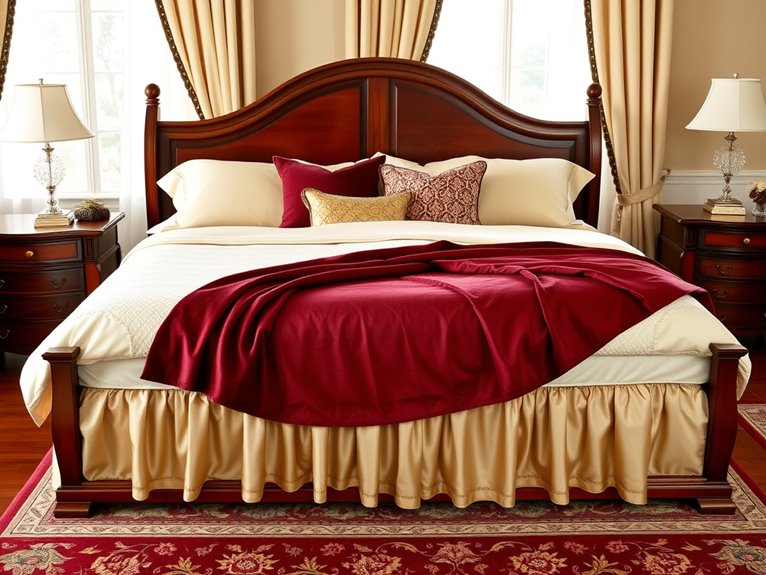
The timeless elegance of a cherry sleigh bed serves as the perfect canvas for creating a luxurious, traditional bedroom aesthetic that exudes warmth and sophistication. The rich, deep tones of cherry wood, combined with the graceful curves of the sleigh design, create a natural focal point that demands equally refined bedding choices and careful styling consideration to enhance its inherent beauty.
This styling technique works particularly well during fall and winter months when warm, layered bedding complements the wood’s natural warmth, though it can be adapted year-round. The heritage approach pairs exceptionally well with traditional, Victorian, and classic American interior design styles, making it ideal for master bedrooms in historic homes or spaces where classic elegance is desired.
Essential Components:
- High-thread-count white or ivory sheets
- Quilted mattress pad
- Down or down-alternative duvet insert
- Damask or jacquard duvet cover in cream, burgundy, or golden tones
- Euro shams (3)
- Standard or king pillow shams (2 pairs)
- Decorative throw pillows (3-5)
- Silk or velvet bed throw
- Dust ruffle or bed skirt
- Pillow inserts
- Steam iron
- Wooden hanger for duvet smoothing
How to Achieve This Look
Begin by creating a pristine foundation with a well-fitted mattress pad and crisp white sheets, ensuring hospital corners are executed perfectly to complement the formal nature of the sleigh bed.
The fitted sheet should be smoothed meticulously, while the flat sheet should be tucked with precise folds that honor the bed’s traditional character.
Layer the bedding by starting with a substantial dust ruffle that grazes the floor, choosing a fabric that echoes the formality of the cherry wood. Position the duvet with equal overhang on both sides, creating gentle folds near the foot of the bed to soften the sleigh bed’s curved features.
Opt for warm-toned patterns or subtle textures that don’t compete with the wood’s natural beauty.
For pillow arrangement, position three Euro shams against the headboard, followed by two pairs of standard or king shams in coordinating but distinct fabrics.
Complete the look with decorative pillows in varying sizes and complementary textures, arranging them in a symmetrical pattern that draws the eye toward the headboard’s graceful curve.
Pro Styling Tips
For the most polished look, press all shams and pillow cases before styling, and consider using pillow forms one size larger than the sham covers for a fuller appearance.
During summer months, swap heavy fabrics for lighter alternatives in the same color family to maintain the heritage feel while adapting to the season.
To preserve the bed’s majestic appearance during daily use, keep decorative pillows and throws stored on a nearby chair or chest, and invest in high-quality pillow inserts that will retain their shape over time.
